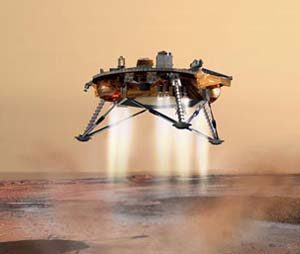It’s snowing on Mars!
 Washington, September 30 : In a discovery that is nothing less than astonishing, NASA’s Phoenix Mars Lander has detected snow falling from Martian clouds.
Washington, September 30 : In a discovery that is nothing less than astonishing, NASA’s Phoenix Mars Lander has detected snow falling from Martian clouds.
A laser instrument designed to gather knowledge of how the atmosphere and surface interact on Mars, detected snow from clouds about 2.5 miles above the spacecraft’s landing site.
Data show the snow vaporizing before reaching the ground.
“Nothing like this view has ever been seen on Mars,” said Jim Whiteway, of York University, Toronto, lead scientist for the Canadian-supplied Meteorological Station on Phoenix. “We’ll be looking for signs that the snow may even reach the ground,” he added.
Spacecraft soil tests experiments also have provided evidence of past interaction between minerals and liquid water, processes that occur on Earth.
Phoenix experiments also yielded clues pointing to calcium carbonate, the main composition of chalk, and particles that could be clay.
Most carbonates and clays on Earth form only in the presence of liquid water.
“We are still collecting data and have lots of analysis ahead, but we are making good progress on the big questions we set out for ourselves,” said Phoenix Principal Investigator Peter Smith of the University of Arizona, Tucson.
Since landing on May 25, Phoenix already has confirmed that a hard subsurface layer at its far-northern site contains water-ice.
Determining whether that ice ever thaws would help answer whether the environment there has been favorable for life, a key aim of the mission.
The evidence for calcium carbonate in soil samples from trenches dug by the Phoenix robotic arm comes from two laboratory instruments called the Thermal and Evolved Gas Analyzer, or TEGA, and the wet chemistry laboratory of the Microscopy, Electrochemistry and Conductivity Analyzer, or MECA.
“We have found carbonate,” said William Boynton of the University of Arizona, lead scientist for the TEGA. “This points toward episodes of interaction with water in the past,” he added.
Both TEGA, and the microscopy part of MECA have turned up hints of a clay-like substance.
According to Michael Hecht, MECA lead scientist at NASA’s Jet Propulsion Laboratory in Pasadena, California, “We are seeing smooth-surfaced, platy particles with the atomic-force microscope, not inconsistent with the appearance of clay particles.” (ANI)